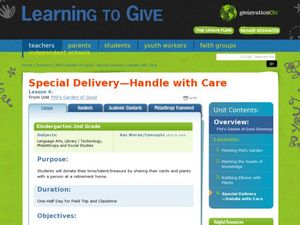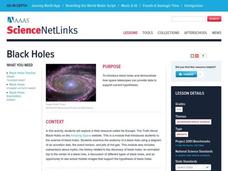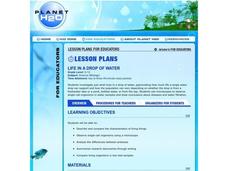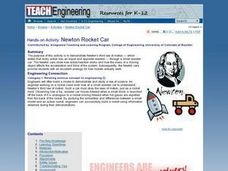Curated OER
Our Desert Backyard
Students make observations of their own backyard. In this environment activity, students keep records of the plants and animals they see in their home or school yard. Students make notes of how the weather and environment changes over...
Curated OER
Fluke: Whale Watching Activity
Sixth graders observe and record data about humpback whales in Hawaii. In this humpback whale watching lesson, 6th graders watch the activity of whales from a Hawaiian beach. They record data about their behavior and complete a research...
Curated OER
What's in a Name?
Students study the binomial system of naming organisms. They are given a name of an organism and they must draw a picture of what they think the organism looks like. Then they research the organism, find what it really looks like, and...
Curated OER
Dinosaurs Here Yesterday Gone Today
Learners take a pre-test to show their prior knowledge of dinosaurs. Using the internet, they reasearch the time period in which they roamed the Earth. Focusing on the area of Connecticut, they compare and contrast the large and small...
Curated OER
Fin, Feathers, or Fur?
Students learn how to classify animals. In this animal characteristics lesson, students read Granddad's Animal Alphabet Book, brainstorm a list of different kinds of animals, and determine their characteristics; fur, feathers or scales....
Curated OER
Magic School Bus: The Wild Whale Watch Lesson Plan
Students research information about whales. In this early childhood lesson plan, students create an illustration of a whale to display in a sea scene in the classroom. Students then use the library and internet to research a whale of...
Curated OER
The Magic School Bus Gets Ants in Its Pants
Students learn along with Ms. Frizzle's class. In this Magic School Bus lesson plan, students observe ants doing some tasks by making them a temporary indoor home.
Curated OER
Arthropods at Home- Spider, Isopod, or Any Arthropod
Students design a habitat for an arthropod. For this organisms lesson, students read the book, A House is a House For Me. Students find an arthropod and create a terrarium.
Curated OER
Simple Thermodynamics of Transportation
Students watch videos about various modes of transportation, they examine the energy transformations that occur in each, and they be introduced to the laws of thermodynamics.
Curated OER
Paleontology: A Field Experience
Young scholars go to a dig where they prospect for bones which simulate fossils. They encase the bones in plaster and transport them back to school for further investigation.
Curated OER
Bee Dance
Everything a bee does serves a purpose. Learners in grades one through five explore the behaviors of bees through reading and dramatic puppet play. First children will create honey bee puppets, then they will discuss how bees dance to...
Curated OER
Animal Hide and Seek
Students examine how animals use their colors to their advantage. They read the book, "Brown Bear, Brown Bear, What Do You See?," participate in a toothpick camouflaging demonstration, explore the Camouflage Field Book website,...
Curated OER
The Facts of Life
Students explore the different ways scientists gather information about extinct animals. They utilize these methods to create illustrated story books about a particular extinct animal.
Curated OER
Exploring the Great Salt Lake
Third graders participate in a scavenger hunt, looking for things that are unique about the ecosystem in and around the lake. They observe and describe a variety of habitats and distinguish living and nonliving elements of...
Curated OER
Shrinking Spaces
Students describe the impact of population growth on the environment. They describe how cities affect their surrounding environment and explain how cities are handling growth and its resulting effect on the quality of life. They visit...
Curated OER
Changing Landforms
Students investigate different types of landforms. In this landforms lesson plan, students explore landforms by participating in a WebQuest. Students research the reasons behind landforms changing and create a picture using KidPix.
Curated OER
Phil's Garden of Good
Students read "The Rainbow Fish" and discuss how the fish benefited by giving others. In this sharing lesson, students prepare plants and letters for senior citizens. Students present their letters and plants at a visit to a senior...
Curated OER
Water Wonders
Students explore hydrology concepts. In this environment and biology lesson, students identify and describe macroinvertebrates using a variety of pictures and resources. Students observe and write about a classroom aquarium in which...
Curated OER
What Kind of Garden Would Grow in Our Schoolyard?
Students perform soil tests for pH, nitrogen, phosphorus, potassium, composition and water percolation rate and assess the conditions in the schoolyard.
Curated OER
Trichinella Forensics
Students engage in DNA manipulation using forensics techniques. Students investigate topics involved in forensics studies such as cloning, electrophoresis, gene mapping, replication, and transcription.
Curated OER
Why Do We Have Night?
Students engage in a fun, creative way to discover how the Earth moves. This lesson helps students explain why there is day and night. It can also create curiosity to further study the solar system and eclipses!
Curated OER
Black Holes
Students study black holes and see how space telescopes can provide data to support current hypotheses. They examine the anatomy of a black hole using a diagram of an accretion disk, the event horizon, and jets of hot gas.
Curated OER
Life in a Drop of Water
High schoolers examine the structure, function, and characteristics of microscopic organisms that inhabit freshwater through collection of water samples and observation through microscopes.
Curated OER
Newton Rocket Car
Learners observe a demonstration of Newton's third law of motion using a small wooden car. They discuss Newton's third law of motion and what happens to motion if the mass or acceleration is increased, construct their car, and record...























